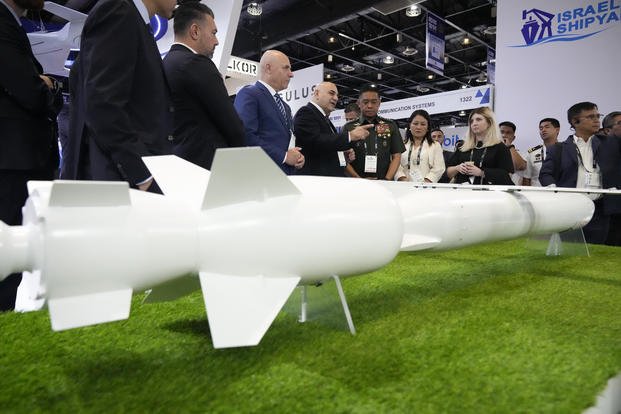MANILA, Philippines — American and Filipino security officials have agreed to keep a U.S. mid-range missile system in the northern Philippines indefinitely to boost deterrence despite China’s expressions of alarm, two Philippine officials said Wednesday.
The U.S. Army transported the Typhon missile system, a land-based weapon that can fire the Standard Missile-6 and the Tomahawk Land Attack Missile, to the northern Philippines as part of combat exercises in April with Philippine troops and to test its deployability aboard an Air Force aircraft.
Tomahawk missiles can travel over 1,000 miles (1,600 kilometers), which places China within their target range. Officials are considering keeping the missile system in the northern Philippines up to April next year, when U.S. and Philippine forces are scheduled to hold their annual Balikatan — Tagalog for “shoulder-to-shoulder” — large-scale combat exercises, he said.
The two officials spoke to The Associated Press on condition of anonymity because they were not authorized to discuss the sensitive U.S. missile deployment publicly. There was no immediate immediate comment from U.S. officials.
Chinese diplomats have repeatedly conveyed their alarm to the Philippine government, warning that the deployment of the missile system could destabilize the region.
A Philippine army spokesperson said earlier that the system was scheduled to be removed from the country by the end of this month. Philippine Defense Secretary Gilberto Teodoro Jr. refused to confirm or deny the extension.
But Teodoro rejected China’s demands as interference in the Philippines internal affairs, speaking to reporters Tuesday on the sidelines of an Asian defense industry exhibition in Manila.
“China is saying that they are alarmed but that is interference into our internal affairs. They are using reverse psychology in order to deter us from building up our defensive capabilities,” Teodoro said.
“Before they start talking, why don’t they lead by example? Destroy their nuclear arsenal, remove all their ballistic missile capabilities, get out of the West Philippines Sea and get out of Mischief Reef,” Teodoro said. “I mean, don’t throw stones when you live in a glass house.”
Teodoro used the Philippine name for the disputed South China Sea and for a contested reef off the western Philippines that Chinese forces seized in 1995 and is now one of seven missile-protected island bases China maintains in the disputed waters.
Philippine military chief Gen. Romeo Brawner Jr. said he has asked U.S. military officials to keep the missile system in the Philippines, but declined to say what was their response. “If I were given the choice, I would like to have the Typhon here in the Philippines forever because we need it for our defense,” Brawner told reporters.
Last month, Philippine Foreign Secretary Enrique Manalo said his Chinese counterpart Wang Yi expressed China’s “very dramatic” concern over the U.S. mid-range missile deployment to the Philippines during their recent talks in Laos on the sidelines of the Association of Southeast Asian Nations meetings with Asian and Western countries.
Manalo said Wang warned the presence of the U.S. missile system could be “destabilizing,” but he said that he disagreed. “They’re not destabilizing” and the missile system was only in the Philippines temporarily, Manalo said he told Wang.
Although the missile system was transported to the Philippines for joint combat exercises in April, it was not fired during the joint drills by the longtime treaty allies, according to Philippine and U.S. military officials.
China has strongly opposed increased U.S. military deployments to the region, including to the Philippines, saying they could endanger regional stability and peace.
The U.S. and the Philippines have repeatedly condemned China’s increasingly assertive actions to fortify its territorial claims in the South China Sea, where hostilities have flared since last year with repeated clashes between Chinese and Philippine coast guard forces and accompanying vessels.
Aside from China and the Philippines, Vietnam, Malaysia, Brunei and Taiwan also have overlapping claims in the busy waterway, a key global and security route which is also believed to be sitting atop vast undersea deposits of gas and oil.
Associated Press journalist Aaron Favila contributed to this report.
Story Continues
© Copyright 2024 Associated Press. All rights reserved. This material may not be published, broadcast, rewritten or redistributed.
Read the full article here

